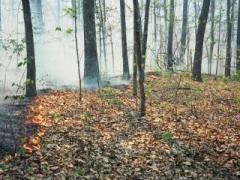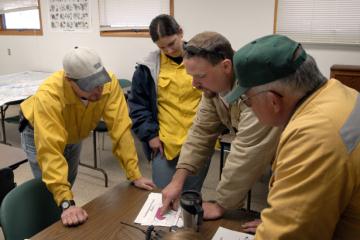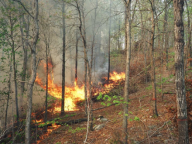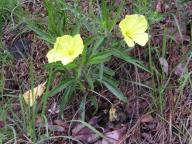Fire is one management tool that can be used to control the dominance of sericea lespedeza (Lespedeza cuneata). Data from Kansas and Oklahoma suggests growing-season fire can be more detrimental to sericea than dormant-season fire. Prescribed fire can limit sericea seed production if burned before the plant produces seed. Following fire, sericea is palatable to livestock as tannin levels are lower immediately following germination or resrouting as compared to a mature plant. Using a patch-burning system (e.g., burning a portion of a pasture each year) higher levels of sericea consumption by livestock have been demonstrated as cattle concentrate or continuously graze on the recently burned patch. Using patch-burning, coverage of sericea has increased at a lower rate as compared to more traditional fire and grazing applications where the entire pasture is burned. In some cases, a combination of burning, grazing and herbicide applications may be necessary to control sericea.
Can I use herbicide, grazing, or mechanical methods rather than prescribed fire?
This depends on your management goals and objectives. Consider the fact that fire has unique properties and different effects that cannot be completely duplicated with other methods. For example, the heat from fire is necessary for seed germination in some plant species, the chemical-physical reaction from fire can alter nutrient availability and affect forage palatability, and increased soil temperature following fire can alter plant emergence in spring. The opposite also holds true. That is, herbicide, grazing, and mechanical methods can produce results that fire cannot exactly duplicate. Therefore, it is important to understand and define your management objectives in order to best apply the appropriate practice(s). Visit with your local Extension agent or specialist to help make this determination.
Does fire occur in wetlands?
Yes, many wetlands do periodically burn, both from wildfire and prescribed fire. Many wetlands are only seasonally wet, so they are susceptible to fire during the dry period. Fire can be used to alter the structure of vegetation in a wetland to meet certain management objectives. A specific example includes burning cattail mashes in the Northern Great Plains to benefit waterfowl. Also, periodic wildfire in the Everglades is important to remove accumulated peat from wetlands which allow for greater water depth during wet periods. These deep water areas are important for certain wildlife species such as the American alligator.
Setting Prescribed Fire Objectives

Prescribed fire is an effective tool for managing vegetation. Prescribed fire can be used to improve forage for livestock and wildlife, control both non-native and native invasive species, remove leaf litter, reduce logging debris, improve tree regeneration, and manage vegetation competion. Fire is an excellent tool for vegetation management, but prescribed fires need to be planned to consistently achieve the beneficial effects.
A successful prescribed fire program involves three steps:
1) planning-including evaluating the condition of vegetation and vegetation management goals
2) safe and effective prescribed fire execution
3) sound vegetation management pre-, during, and post-prescribed fire treatment. A prescribed fire plan is an essential part of the process for preparing to use prescribed fire.
The prescribed fire plan includes prescribed fire objectives, weather conditions, plans for fire control, identification of authorities to notify prior to prescribed fire ignition, prescribed fire ignition plans, and post-prescribed fire plans. Below are links to sites with information on prescribed fire planning: Michigan Department of Natural Resources, Florida Forest Service, U.S. Forest Service Southern Research Station, Georgia Forestry Commission, New Hampshire Prescribed Fire Council, and Oklahoma State University.
Determining Land Management Objectives
 Planning to use prescribed fire starts with determining what the land management objectives are and deciding if prescribed fire will help achieve the objectives. This process can take some time, but it is very important for determining where, when, and how prescribed fire can be used. Once it is determined that prescribed fire is an appropriate tool to meet the objectives, then a prescribed fire plan should be prepared. The prescribed fire plan is a document that describes the area to be treated with fire, the prescribed fire objectives, and a plan that includes a combination of prescribed fire ignition techniques, season of burn, and weather conditions to meet the defined objectives. Setting the objectives of the prescribed fire is a very important step in prescribed fire use.
Planning to use prescribed fire starts with determining what the land management objectives are and deciding if prescribed fire will help achieve the objectives. This process can take some time, but it is very important for determining where, when, and how prescribed fire can be used. Once it is determined that prescribed fire is an appropriate tool to meet the objectives, then a prescribed fire plan should be prepared. The prescribed fire plan is a document that describes the area to be treated with fire, the prescribed fire objectives, and a plan that includes a combination of prescribed fire ignition techniques, season of burn, and weather conditions to meet the defined objectives. Setting the objectives of the prescribed fire is a very important step in prescribed fire use.
Prescribed fire objectives need to provide enough detail that the prescribed fire can be evaluated to determine if it was successful. Objectives can be both short- and long-term. Short-term objectives should be quantifiable.
Short-Term Objectives
- Reduce leaf litter by 70%
- Reduce understory shrubs by 50%
- Consume 60% of tree branches less than 1inch in diameter from logging debris.
- Consume 90% of fine fuels.
- Increase grass cover by 20%
- Increase native plant species richness by 5 species.
Long-Term Objectives
Long-term objectives can include the desired future conditions that the landowner is trying to achieve by using prescribed fire. Examples of long-term objectives are:
- Promote native grasses.
- Reduce the cover of exotic species
- Restore woodland structure
- Convert site from hardwoods to softwoods
- Improve forage for livestock



Additional Literature:
Fire in southern forests: http://www.treesearch.fs.fed.us/pubs/6462
Fire in Ponderosa Pine Forests in the Pacific Northwest: http://www.treesearch.fs.fed.us/pubs/21805
Prescribed fire effects literature review and synthesis: http://www.treesearch.fs.fed.us/pubs/33628
Managing Northern Bobwhite with Prescribed Fire

The northern bobwhite is a popular gamebird and many landowners wish to improve populations of this quail on their land. Practices such as timber thinning, disking, herbicide applications, and food plots are commonly implemented for bobwhites. However, prescribed fire is implemented by far fewer landowners. This resistance to use fire is unfortunate because fire benefits bobwhite more than any other practice.
Impacts of fire
Bobwhite require short, dense, woody cover (shrubs), perennial grass cover, bare ground, and abundant forbs (broadleaf herbaceous plants) with an open structure at ground level. Fire is an effective tool to manipulate all of these factors. Fire removes dead plant material, opens the structure of vegetation at ground level, and stimulates annual food-producing forbs to germinate. In a forest, fire can be used following a harvest or thinning that allows at least 50% sunlight into the stand. Burning these stands consumes leaf litter and stimulates a lush understory that provides better cover and more food, especially seed and soft mast.
Frequency
Fire frequency is the most important factor when using fire for bobwhite management. The ideal frequency depends on the plant community, precipitation, and soil type. In general, a short fire-return interval is needed in the eastern portions of the bobwhite range. Areas of the Gulf Coastal Plain may need fire every 1 – 2 years to maintain the early seral stages required by bobwhite quail in these areas. On the western edge of the bobwhite range where precipitation is much less, fire frequencies can be longer. Burning once every 10 years will maintain the plant community in a suitable composition and structure.

Seasonality
Although fire frequency is the most important factor, season of fire can also be influencial. Fire in different seasons will tend to favor certain plants that may be more or less desirable for bobwhite. This is highly variable from place to place. However, in general, summer fires tend to reduce woody plant composition more than dormant-season fires. So, if your goal is to reduce woody plants and increase herbaceous plants, burning during the growing season should be considered.
Additional considerations
Similar to haying, burning during the nesting season can destroy nests. Most bobwhite nesting occurs May-July. So if growing-season fire is needed to control woody species, burning late in the growing season should be considered. Also, if a large area is burned in the spring, perennial grass cover for nesting will be lacking that year. Therefore, only a portion of the landscape should be burned in any one year. However, in areas that receive a lot of rain, such as the Gulf Coastal region, grass cover returns quickly following fire and quail may nest in that year’s burned area. Fire also temporarily removes shrub cover. However, most shrubs resprout and the resprouts are often more dense a year or two following fire.This further implies that only a portion of the landscape should be burned each year.
With a little experience and knowledge, landowners can effectively use prescribed fire to manage bobwhite habitat. Fire historically maintained healthy bobwhite populations and it can continue to do so today.
